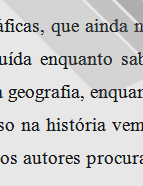

................................
Since 1955, Magalhães Godinho had raised two names in geography for a broadened history encompassing the social sciences: Orlando Ribeiro and Fernandes Martins (Godinho, “A Historiografia,” ["Historiography"] p. 16). Strongly influenced by his long stay and studies (or further refinement) in Paris, by 1965 Magalhães Godinho envisioned an expanded scope for human geography.
“Instead of the traditional geographical 'framework' serving as an introduction only to be quickly forgotten, history considers the actions of men in each era in relation to a concrete space (and not merely a map of toponymic locations). It seeks, as it were, to conduct retrospective human geography (Roger Dion) or geohistory (Braudel), that is, to reconstruct the landscapes of the time and the forms that characterised human interactions with them” (Godinho, “Sobre,” p. 147). He consistently relied on the cartographic approaches of Jacques Bertin, which he encouraged his collaborators to study. With similarly long stays in France, Luís de Matos and Joaquim Barradas de Carvalho conducted their research in cultural history, never neglecting geography. Whether dealing with the Latin literature of the expansion or delving into Duarte Pacheco Pereira’s Esmeraldo de Situ Orbis, the study of lands and seas required the support and insights of geographical science.
At the Faculty of Arts in Lisbon, Virgínia Rau began her career studying the Middle Ages: her focus in 1943 was on fairs; she then turned to research on the sesmarias (1946) and moved on to a different period with A exploração e o comércio do sal de Setúbal – estudo de história económica [The Exploration and Trade of Salt in Setúbal – A Study in Economic History] (1951), alongside numerous articles and dispersed contributions. Initially, she paid some attention to pre-history and geography, maintaining “intense interactions” with geographers (Ribeiro, Introduções, p. 129, n. 6)—to the point of co-authoring a guidebook for the 1949 International Geography Congress on the Ribatejo and Estremadura regions with geologist G. Zbyszewski. However, she eventually abandoned this focus, despite her close association with Orlando Ribeiro. Jorge Borges de Macedo only appears to have paid more attention to geography with his study on Portuguese industry (1965), which inevitably required explaining the locations chosen by the various establishments. However, even in his studies on foreign policy, he did not appear to give geography its due importance, as his scope leaned more towards cultural and diplomatic history. For A. H. de Oliveira Marques, geography also played a role in historical reasoning and construction, as highlighted in his thesis (which he was not allowed to defend), Introdução à história da agricultura em Portugal. A questão cerealífera [Introduction to the History of Agriculture in Portugal: The Cereal Question] (1962). Whenever dealing with the natural environment, the use of geographical knowledge became imperative .
